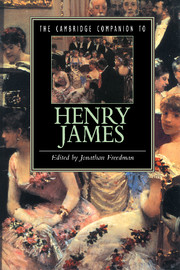Book contents
- Frontmatter
- Introduction: The Moment of Henry James
- 1 Men, Women, and the American Way
- 2 The James Family Theatricals
- 3 Henry James at Work
- 4 Henry James and the Invention of Novel Theory
- 5 Henry James and the Idea of Evil
- 6 Queer Henry In the Cage
- 7 The Unmentionable Subject in "The Pupil"
- 8 Realism, Culture, and the Place of the Literary: Henry James and The Bostonians
- 9 Lambert Strether's Excellent Adventure
- 10 James's Elusive Wings
- 11 Henry James's American Dream in The Golden Bowl
- 12 Affirming the Alien: The Pragmatist Pluralism of The American Scene
- Suggestions for Further Reading
- Index
- Series List
5 - Henry James and the Idea of Evil
Published online by Cambridge University Press: 28 May 2006
- Frontmatter
- Introduction: The Moment of Henry James
- 1 Men, Women, and the American Way
- 2 The James Family Theatricals
- 3 Henry James at Work
- 4 Henry James and the Invention of Novel Theory
- 5 Henry James and the Idea of Evil
- 6 Queer Henry In the Cage
- 7 The Unmentionable Subject in "The Pupil"
- 8 Realism, Culture, and the Place of the Literary: Henry James and The Bostonians
- 9 Lambert Strether's Excellent Adventure
- 10 James's Elusive Wings
- 11 Henry James's American Dream in The Golden Bowl
- 12 Affirming the Alien: The Pragmatist Pluralism of The American Scene
- Suggestions for Further Reading
- Index
- Series List
Summary
Henry James needed an imagination of Evil; it was a requirement of his artistic vocation as well as his personal identity. He had a huge ambition not only for his own fiction, but for the novel generally, which in his moment was still an adolescent inhabiting the outskirts of cultural respectability, where film (or “the movies”) lived twenty years ago. James worked as a propagandist for the genre, playing a kind of shell game by worrying in his essays or prefaces over various aspects of fictional composition, as though one could simply assume for it the serious stature of lyric, epic, and dramatic poetry. But when in his own work he wanted to connect allusively to these established literary traditions, the problem of Evil became his chief conduit. I want here to examine this process in two of James's most famous short works, Daisy Miller and The Turn of the Screw, and one of the great novels, The Portrait of a Lady, to question why Evil so dominates his imagination when the very concept had, by his own estimation, become creaky, suspect, lame.
- Type
- Chapter
- Information
- The Cambridge Companion to Henry James , pp. 102 - 119Publisher: Cambridge University PressPrint publication year: 1998
- 1
- Cited by



